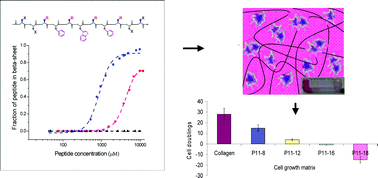De novo designed positively charged tape-forming peptides: self-assembly and gelation in physiological solutions and their evaluation as 3D matrices for cell growth†
Abstract
Learning to control self-assembling

* Corresponding authors
a
Centre for Molecular Nanoscience (CMNS), School of Chemistry, University of Leeds, Leeds, UK
E-mail:
a.aggeli@leeds.ac.uk
Fax: +44 (0)113 343 6452
Tel: +44 (0)113 343 6407
b
The Institute of Medical and Biological Engineering (iMBE), University of Leeds, Leeds, UK
E-mail:
e.ingham@leeds.ac.uk
Fax: +44 (0)113 2424611
Tel: +44(0) 113 34 35691
Learning to control self-assembling

 Please wait while we load your content...
Something went wrong. Try again?
Please wait while we load your content...
Something went wrong. Try again?
S. Maude, D. E. Miles, S. H. Felton, J. Ingram, L. M. Carrick, R. K. Wilcox, E. Ingham and A. Aggeli, Soft Matter, 2011, 7, 8085 DOI: 10.1039/C0SM00974A
To request permission to reproduce material from this article, please go to the Copyright Clearance Center request page.
If you are an author contributing to an RSC publication, you do not need to request permission provided correct acknowledgement is given.
If you are the author of this article, you do not need to request permission to reproduce figures and diagrams provided correct acknowledgement is given. If you want to reproduce the whole article in a third-party publication (excluding your thesis/dissertation for which permission is not required) please go to the Copyright Clearance Center request page.
Read more about how to correctly acknowledge RSC content.
 Fetching data from CrossRef.
Fetching data from CrossRef.
This may take some time to load.
Loading related content
